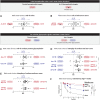This is a preprint.
C. elegans males optimize mate-choice decisions via sex-specific responses to multimodal sensory cues
- PMID: 37066192
- PMCID: PMC10104232
- DOI: 10.1101/2023.04.08.536021
C. elegans males optimize mate-choice decisions via sex-specific responses to multimodal sensory cues
Update in
-
C. elegans males optimize mate-preference decisions via sex-specific responses to multimodal sensory cues.Curr Biol. 2024 Mar 25;34(6):1309-1323.e4. doi: 10.1016/j.cub.2024.02.036. Epub 2024 Mar 11. Curr Biol. 2024. PMID: 38471505 Free PMC article.
Abstract
For sexually reproducing animals, selecting optimal mates is essential for maximizing reproductive fitness. Because the nematode C. elegans reproduces mostly by self-fertilization, little is known about its mate-choice behaviors. While several sensory cues have been implicated in males' ability to recognize hermaphrodites, achieving an integrated understanding of the ways males use these cues to assess relevant characteristics of potential mates has proven challenging. Here, we use a choice-based social-interaction assay to explore the ability of C. elegans males to make and optimize mate choices. We find that males use a combination of volatile sex pheromones (VSPs), ascaroside pheromones, surface-bound chemical cues, and other signals to robustly assess a variety of features of potential mates. Specific aspects of mate choice are communicated by distinct signals: the presence of a sperm-depleted, receptive hermaphrodite is likely signaled by VSPs, while developmental stage and sex are redundantly specified by ascaroside pheromones and surface-associated cues. Ascarosides also signal nutritional information, allowing males to choose well-fed over starved mates, while both ascarosides and surface-associated cues cause males to prefer virgin over previously mated hermaphrodites. The male-specificity of these behavioral responses is determined by both male-specific neurons and the male state of sex-shared circuits, and we reveal an unexpected role for the sex-shared ASH sensory neurons in male attraction to endogenously produced hermaphrodite ascarosides. Together, our findings lead to an integrated view of the signaling and behavioral mechanisms by which males use diverse sensory cues to assess multiple features of potential mates and optimize mate choice.
Conflict of interest statement
DECLARATION OF INTERESTS The authors declare no competing interests.
Figures








Similar articles
-
C. elegans males optimize mate-preference decisions via sex-specific responses to multimodal sensory cues.Curr Biol. 2024 Mar 25;34(6):1309-1323.e4. doi: 10.1016/j.cub.2024.02.036. Epub 2024 Mar 11. Curr Biol. 2024. PMID: 38471505 Free PMC article.
-
Chemical mating cues in C. elegans.Semin Cell Dev Biol. 2014 Sep;33:18-24. doi: 10.1016/j.semcdb.2014.06.002. Epub 2014 Jun 27. Semin Cell Dev Biol. 2014. PMID: 24977334 Review.
-
A sexually conditioned switch of chemosensory behavior in C. elegans.PLoS One. 2013 Jul 4;8(7):e68676. doi: 10.1371/journal.pone.0068676. Print 2013. PLoS One. 2013. PMID: 23861933 Free PMC article.
-
A Single-Neuron Chemosensory Switch Determines the Valence of a Sexually Dimorphic Sensory Behavior.Curr Biol. 2018 Mar 19;28(6):902-914.e5. doi: 10.1016/j.cub.2018.02.029. Epub 2018 Mar 8. Curr Biol. 2018. PMID: 29526590 Free PMC article.
-
Ascaroside signaling in C. elegans.WormBook. 2013 Jan 18:1-22. doi: 10.1895/wormbook.1.155.1. WormBook. 2013. PMID: 23355522 Free PMC article. Review.
References
-
- Bateson P.P.G. (1983). Mate choice (Cambridge University Press; ).
-
- Møller A.P. (1994). Sexual selection and the barn swallow (Oxford University Press; ).
Publication types
Grants and funding
LinkOut - more resources
Full Text Sources
Research Materials
Miscellaneous
